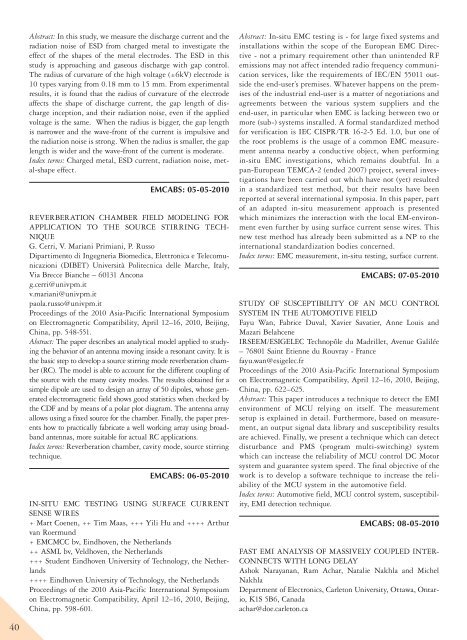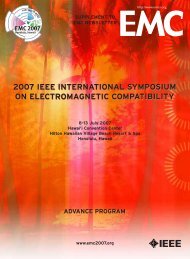Tutorial: EMC & Signal Integrity using SPICE, page 44 - IEEE EMC ...
Tutorial: EMC & Signal Integrity using SPICE, page 44 - IEEE EMC ...
Tutorial: EMC & Signal Integrity using SPICE, page 44 - IEEE EMC ...
Create successful ePaper yourself
Turn your PDF publications into a flip-book with our unique Google optimized e-Paper software.
40<br />
Abstract: In this study, we measure the discharge current and the<br />
radiation noise of ESD from charged metal to investigate the<br />
effect of the shapes of the metal electrodes. The ESD in this<br />
study is approaching and gaseous discharge with gap control.<br />
The radius of curvature of the high voltage (±6kV) electrode is<br />
10 types varying from 0.18 mm to 15 mm. From experimental<br />
results, it is found that the radius of curvature of the electrode<br />
affects the shape of discharge current, the gap length of discharge<br />
inception, and their radiation noise, even if the applied<br />
voltage is the same. When the radius is bigger, the gap length<br />
is narrower and the wave-front of the current is impulsive and<br />
the radiation noise is strong. When the radius is smaller, the gap<br />
length is wider and the wave-front of the current is moderate.<br />
Index terms: Charged metal, ESD current, radiation noise, metal-shape<br />
effect.<br />
<strong>EMC</strong>ABS: 05-05-2010<br />
REVERBERATION CHAMBER FIELD MODELING FOR<br />
APPLICATION TO THE SOURCE STIRRING TECH-<br />
NIQUE<br />
G. Cerri, V. Mariani Primiani, P. Russo<br />
Dipartimento di Ingegneria Biomedica, Elettronica e Telecomunicazioni<br />
(DIBET) Università Politecnica delle Marche, Italy,<br />
Via Brecce Bianche – 60131 Ancona<br />
g.cerri@univpm.it<br />
v.mariani@univpm.it<br />
paola.russo@univpm.it<br />
Proceedings of the 2010 Asia-Pacific International Symposium<br />
on Electromagnetic Compatibility, April 12–16, 2010, Beijing,<br />
China, pp. 548-551.<br />
Abstract: The paper describes an analytical model applied to studying<br />
the behavior of an antenna moving inside a resonant cavity. It is<br />
the basic step to develop a source stirring mode reverberation chamber<br />
(RC). The model is able to account for the different coupling of<br />
the source with the many cavity modes. The results obtained for a<br />
simple dipole are used to design an array of 50 dipoles, whose generated<br />
electromagnetic field shows good statistics when checked by<br />
the CDF and by means of a polar plot diagram. The antenna array<br />
allows <strong>using</strong> a fixed source for the chamber. Finally, the paper presents<br />
how to practically fabricate a well working array <strong>using</strong> broadband<br />
antennas, more suitable for actual RC applications.<br />
Index terms: Reverberation chamber, cavity mode, source stirring<br />
technique.<br />
<strong>EMC</strong>ABS: 06-05-2010<br />
IN-SITU <strong>EMC</strong> TESTING USING SURFACE CURRENT<br />
SENSE WIRES<br />
+ Mart Coenen, ++ Tim Maas, +++ Yili Hu and ++++ Arthur<br />
van Roermund<br />
+ <strong>EMC</strong>MCC bv, Eindhoven, the Netherlands<br />
++ ASML bv, Veldhoven, the Netherlands<br />
+++ Student Eindhoven University of Technology, the Netherlands<br />
++++ Eindhoven University of Technology, the Netherlands<br />
Proceedings of the 2010 Asia-Pacific International Symposium<br />
on Electromagnetic Compatibility, April 12–16, 2010, Beijing,<br />
China, pp. 598-601.<br />
Abstract: In-situ <strong>EMC</strong> testing is - for large fixed systems and<br />
installations within the scope of the European <strong>EMC</strong> Directive<br />
- not a primary requirement other than unintended RF<br />
emissions may not affect intended radio frequency communication<br />
services, like the requirements of IEC/EN 55011 outside<br />
the end-user’s premises. Whatever happens on the premises<br />
of the industrial end-user is a matter of negotiations and<br />
agreements between the various system suppliers and the<br />
end-user, in particular when <strong>EMC</strong> is lacking between two or<br />
more (sub-) systems installed. A formal standardized method<br />
for verification is IEC CISPR/TR 16-2-5 Ed. 1.0, but one of<br />
the root problems is the usage of a common <strong>EMC</strong> measurement<br />
antenna nearby a conductive object, when performing<br />
in-situ <strong>EMC</strong> investigations, which remains doubtful. In a<br />
pan-European T<strong>EMC</strong>A-2 (ended 2007) project, several investigations<br />
have been carried out which have not (yet) resulted<br />
in a standardized test method, but their results have been<br />
reported at several international symposia. In this paper, part<br />
of an adapted in-situ measurement approach is presented<br />
which minimizes the interaction with the local EM-environment<br />
even further by <strong>using</strong> surface current sense wires. This<br />
new test method has already been submitted as a NP to the<br />
international standardization bodies concerned.<br />
Index terms: <strong>EMC</strong> measurement, in-situ testing, surface current.<br />
<strong>EMC</strong>ABS: 07-05-2010<br />
STUDY OF SUSCEPTIBILITY OF AN MCU CONTROL<br />
SYSTEM IN THE AUTOMOTIVE FIELD<br />
Fayu Wan, Fabrice Duval, xavier Savatier, Anne Louis and<br />
Mazari Belahcene<br />
IRSEEM/ESIGELEC Technopôle du Madrillet, Avenue Galilée<br />
– 76801 Saint Etienne du Rouvray - France<br />
fayu.wan@esigelec.fr<br />
Proceedings of the 2010 Asia-Pacific International Symposium<br />
on Electromagnetic Compatibility, April 12–16, 2010, Beijing,<br />
China, pp. 622–625.<br />
Abstract: This paper introduces a technique to detect the EMI<br />
environment of MCU relying on itself. The measurement<br />
setup is explained in detail. Furthermore, based on measurement,<br />
an output signal data library and susceptibility results<br />
are achieved. Finally, we present a technique which can detect<br />
disturbance and PMS (program multi-switching) system<br />
which can increase the reliability of MCU control DC Motor<br />
system and guarantee system speed. The final objective of the<br />
work is to develop a software technique to increase the reliability<br />
of the MCU system in the automotive field.<br />
Index terms: Automotive field, MCU control system, susceptibility,<br />
EMI detection technique.<br />
<strong>EMC</strong>ABS: 08-05-2010<br />
FAST EMI ANALYSIS OF MASSIVELY COUPLED INTER-<br />
CONNECTS WITH LONG DELAY<br />
Ashok Narayanan, Ram Achar, Natalie Nakhla and Michel<br />
Nakhla<br />
Department of Electronics, Carleton University, Ottawa, Ontario,<br />
K1S 5B6, Canada<br />
achar@doe.carleton.ca

















